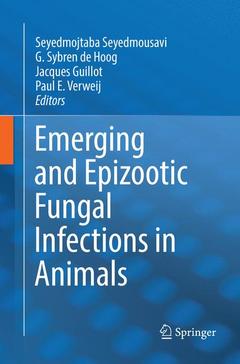Description
Emerging and Epizootic Fungal Infections in Animals, Softcover reprint of the original 1st ed. 2018
Language: English
Subjects for Emerging and Epizootic Fungal Infections in Animals:
Publication date: 01-2019
Support: Print on demand
Publication date: 06-2018
Support: Print on demand
Description
/li>Contents
/li>Biography
/li>Comment
/li>
This book provides in-depth insights into epidemic and emerging mycoses in various animal groups. The different categories of pathogens and outbreak fungi are discussed.
In an introductory chapter, the reader will be provided basic information on fungal infections that are non-transmissible, infections from a common environmental source known as sapronoses, and zoophilic fungal pathogens in various animal species and populations, worldwide
Chapter 2 details the vocabulary and terminology that is required in the scientific literature in order to maintain clarity of expression to the field of Mycology.Chapters 3 to 9 discuss epidemic mycoses with a reservoir in animals and occasional outbreaks, including dermatophytoses, coccidioidomycosis, histoplasmosis, paracoccidioidomycosis, adiaspiromycosis and similar diseases, blastomycosis, and paracoccidioidomycosis ceti (lacaziosis/lobomycosis).
Chapters 10 to 15 comprise emerging mycoses in animals that include feline sporotrichosis, lethargic crab disease, emergence of C. gattii in animals and zoonotic potential, white-nose syndrome in hibernating bats, chytridiomycosis in frogs and salamanders and aspergillosis in cats.
The last chapter is about treatment possibilities, antifungal use in veterinary practice, and emergence of resistance.
The book will address medical and veterinary mycologists, microbiologists, veterinarians, infectious disease specialists, epidemiologists, ecologists, public health scientists from academia and industry as well as graduate students, PhD students and postdocs in the field.
Seyedmojtaba Seyedmousavi
Laboratory of Clinical Immunology and Microbiology, National Institute of Allergy and Infectious Diseases (NIAID), National Institutes of Health (NIH), Bethesda, Maryland, USA
G. Sybren de Hoog
Center of Expertise in Mycology RadboudUMC/CWZ, Nijmegen, and Westerdijk Fungal Biodiversity Institute, Utrecht, The Netherlands.
Jacques Guillot
Department of Parasitology, Mycology and Dermatology, and Dynamyc Research Group, EnvA, UPEC, Ecole nationale vétérinaire d’Alfort, Maisons-Alfort, France
Paul E. Verweij
Department of Medical Microbiology, and Center of Expertise in Mycology RadboudUMC/CWZ, Radboud University Medical Center, Nijmegen, The Netherlands




